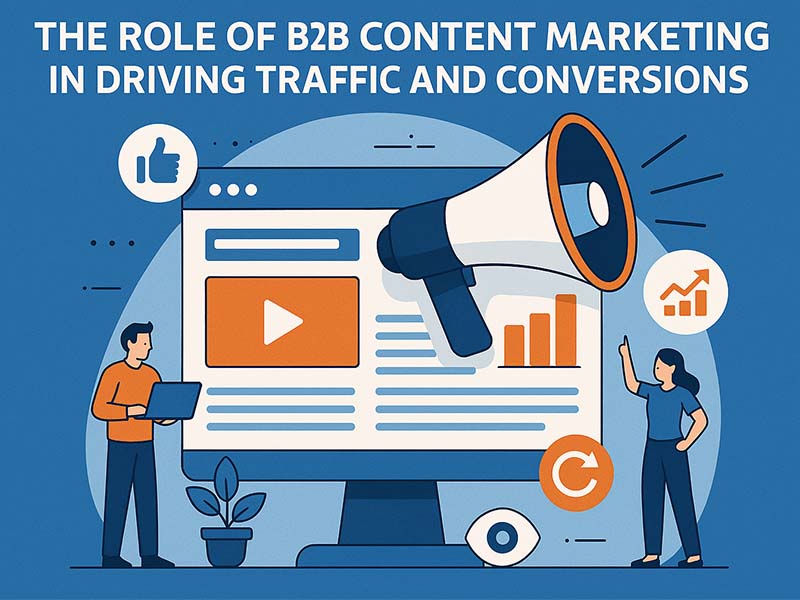The Role of B2B Content Marketing in Driving Traffic and Conversions
In today’s digital-first economy, content is more than just a buzzword it’s a strategic tool for growth. For B2B businesses, content marketing has emerged as a cornerstone for building brand authority, attracting the right audience, and, most importantly, driving traffic and conversions. While traditional outbound methods like cold calls and generic emails still exist, modern B2B buyers prefer valuable, insightful, and solution-driven content. That’s where effective content marketing steps in.
At Substance Communication, we understand how powerful content can be in the B2B landscape. This blog explores how B2B content marketing drives website traffic, generates qualified leads, and improves conversion rates.
Understanding B2B Content Marketing
B2B (business-to-business) content marketing refers to creating and distributing relevant, informative, and valuable content aimed at attracting other businesses. Unlike B2C marketing, B2B content focuses more on education, building trust, and solving industry-specific problems rather than making quick emotional sales.
B2B buyers often go through a longer decision-making cycle. They're not just purchasing for themselves—they're buying on behalf of a team, department, or entire organization. That’s why thoughtful content that addresses pain points, provides actionable insights, and positions your business as a credible authority is essential.
How Content Marketing Drives Traffic
1. Search Engine Optimization (SEO)
Creating high-quality, keyword-rich content helps improve your website’s visibility on search engines. Blog posts, case studies, and guides that answer specific business problems naturally rank better, attracting consistent organic traffic over time.
2. Content Distribution Across Channels
Sharing content through email newsletters, LinkedIn, industry forums, and third-party websites helps attract a qualified audience. Repurposing content into videos, infographics, or carousels extends reach and relevance across platforms.
3. Top-of-Funnel Awareness
Content designed for users at the awareness stage—like explainer blogs, trend analysis, or how-to guides helps introduce your brand to decision-makers who are just beginning to explore solutions.
Turning Traffic into Conversions
Driving traffic is only part of the equation. The real value of B2B content marketing lies in its ability to convert that traffic into leads—and leads into customers.
1. Lead Magnets & Gated Content
Offering valuable resources such as whitepapers, eBooks, or webinars in exchange for contact information is a proven method to generate high-quality leads.
2. Email Nurturing
Once a lead is in your system, send targeted content based on their interests and buyer stage. Drip campaigns with case studies, industry benchmarks, or product updates can build trust and accelerate decisions.
3. Middle & Bottom-Funnel Content
Provide comparison sheets, ROI calculators, and product walkthroughs that directly address buyer concerns and justify their investment. This content moves prospects closer to conversion.
4. Strong Call-to-Actions (CTAs)
Use compelling CTAs across all content whether it’s downloading a resource, requesting a demo, or scheduling a call to guide users to take action.
Types of Content That Drive Results
To truly influence business decisions, your content should be strategic and tailored to different stages of the buyer journey. Some high-performing B2B content types include:
• Case Studies: Real-world results build credibility and show your product in action.
• Whitepapers: Deep dives into industry challenges position your brand as a thought leader.
• Blogs & Articles: Fresh, relevant content improves SEO and provides ongoing value.
• Webinars & Video Tutorials: Engage prospects with live or recorded content that’s informative and actionable.
• Newsletters: Maintain engagement and build long-term relationships through regular communication.
Measuring the Impact of B2B Content Marketing
Success in content marketing isn’t about guesswork—it’s about data. Key performance indicators (KPIs) to track include:
• Website traffic and time on page
• Bounce rate and exit rate
• Lead form submissions
• Content download rates
• Conversion rate (visits to leads, leads to customers)
• Email open and click-through rates
Tools like Google Analytics, HubSpot, and Meta Pixel help track user behavior and optimize content accordingly.
Challenges in B2B Content Marketing (and How to Overcome Them)
1. Creating Enough Quality Content
o Solution: Use a content calendar and repurpose existing material into multiple formats.
2. Aligning Sales and Marketing Goals
o Solution: Collaborate cross-functionally to ensure content addresses common objections and sales questions.
3. Maintaining Consistency
o Solution: Outsource or automate certain processes while retaining editorial control.
Final Thoughts
B2B content marketing is more than just a tactic—it’s a long-term strategy that builds relationships, educates prospects, and turns trust into revenue. From SEO and lead generation to conversion and retention, content is the thread that connects every stage of your buyer's journey. At Substance Communication, we help businesses create, manage, and optimize content strategies that deliver real results. Whether you're launching a new solution, targeting a niche industry, or nurturing your lead pipeline, our expert team can craft content that resonates with decision-makers and drives measurable growth.

